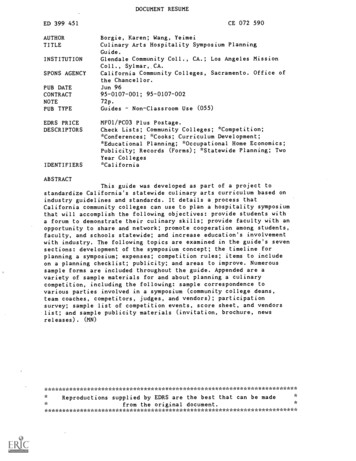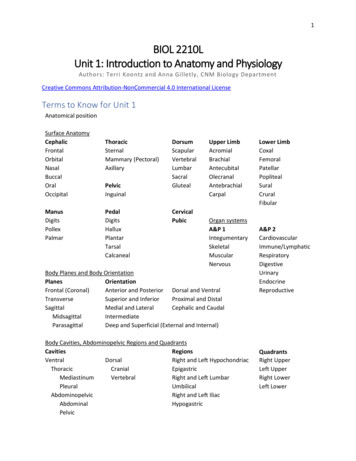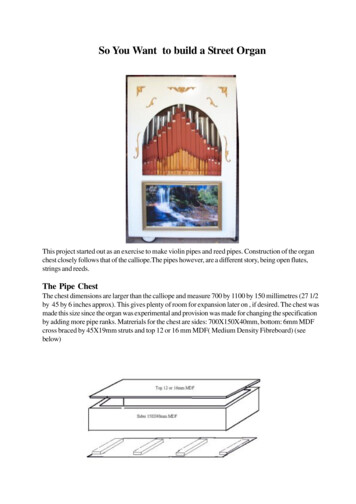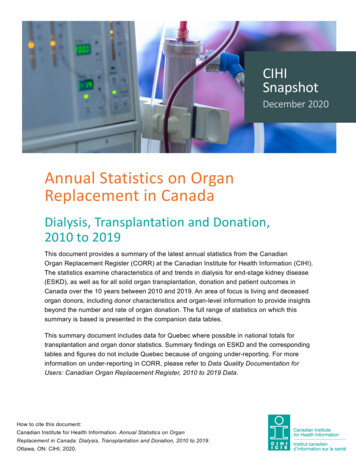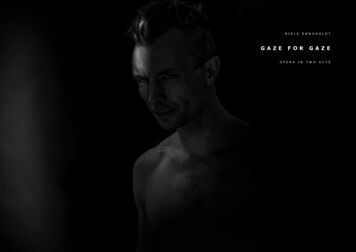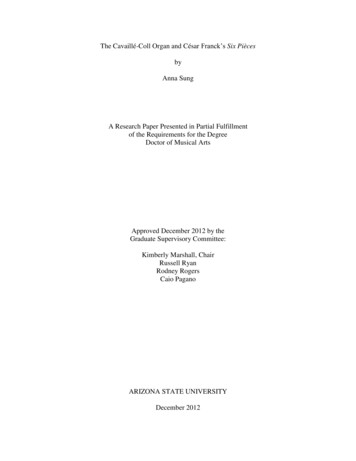
Transcription
The Cavaillé-Coll Organ and César Franck’s Six PiècesbyAnna SungA Research Paper Presented in Partial Fulfillmentof the Requirements for the DegreeDoctor of Musical ArtsApproved December 2012 by theGraduate Supervisory Committee:Kimberly Marshall, ChairRussell RyanRodney RogersCaio PaganoARIZONA STATE UNIVERSITYDecember 2012
ABSTRACTNineteenth-century French organ builder Aristide Cavaillé-Coll andorganist-composersar Franck established a foundation for the revival of organmusic in France. Following the French Revolution, organ culture had degeneratedbecause of the instrument’s association with the church. Beginning with hisinstrument at St. Dénis, Cavaillé-Coll created a new symphonic organ that made itpossible for composers to write organ music in the new Romantic aesthetic.In 1859, Franck received a new Cavaillé-Coll organ at the Parisian churchwhere he served as organist, Sainte-Clotilde. He began experimenting with theinnovations of this instrument: an expressive division, mechanical assists, newtypes of tone color, and an expanded pedal division. From about 1860, Franckbegan composing his first pieces for the Cavaillé-Coll organ; these werepublished in 1868 as the Six Pièces. With these compositions, Franck led the wayin adapting the resources of the French symphonic organ to Romantic music.In this paper, I provide an analysis of the structure of each of the SixPièces as a foundation for exploring ways in which Franck exploited the newfeatures of his Cavaillé-Coll organ. I have made sound recordings to demonstratespecific examples of how the music fits the organ. Thanks to Cavaillé- oll’sinnovations in organ building, Franck was able to write large-scale, multithematic works with the sonorous resources necessary to render themconvincingly. The Six Pièces reveal a strong creative exchange between organistand organ builder, and they portend many of the subsequent developments of theFrench symphonic organ school.i
TABLE OF CONTENTSCHAPTERPage1 INTRODUCTION . 12 ARISTIDE CAVAILLÉ-COLL AND HIS SYMPHONIC ORGAN . 4The Characteristics of the Cavaillé-Coll Organ . 43 ARISTIDE CAVAILLÉ-COLL AND CÉSAR FRANCK . 8The Sainte-Clotilde Organ . 84 FRAN K’S SIX PIÈCES . 14Fantaisie in C Major . 14Grande Pièce Symphonique . 17Prélude, Fugue et Variation . 19Pastorale . 20Prière. 23Final . 245 THE CAVAILLÉ-COLL ORGAN AS VEHICLE FOR FRANCK’SSIX PIÈCES . 26Registrations . 26The use of different divisions . 30Dynamics . 31Touch . 34Expansion of the Récit and Pedal Divisions . 35Summary of Franck’s Use of the availl -Coll Organ in his SixPièces. 36ii
CHAPTERPage6 CONCLUSION . 38REFERENCES . 40APPENDIX A MUSICAL EXAMPLES FOR LECTURE RECITAL . 42iii
CHAPTER 1INTRODUCTIONMusic changes and develops according to contemporary social, politicaland cultural influences. The eighteenth century was a period of drastic changesand industrialization. In the second half of the eighteenth century, these rapidtransformations led to new views on music, art, and literature that challengedclassical concepts in Western Europe. Artists, poets, writers and musiciansexpressed emotional freedom and nationalism through their works, creating a newmusical style. Romantic composers devised long melodies of irregular phraselengths instead of the more symmetrically proportioned lines of the Classical style.The music of Romanticism contained a heightened use of chromaticism, vividcontrasts, and a variety of melodic ideas within one movement to expresschanging emotions. Frequent changes of tempo and meter suggested theunpredictability of human emotions.The piano was an ideal vehicle for music in the new Romantic stylebecause of its flexible dynamics. Virtuoso composers such as Frédéric Chopin(1810-1849) and Franz Liszt (1811-1886) personified the Romantic artist, steeringpiano music towards previously unforeseen directions. Unfortunately, the piano’skeyboard antecedent, the organ, had been victimized by the Revolution. A symbolof clerical and political power, the organ became an easy target for destruction byangry mobs of revolutionaries. Although some instruments were saved when theysounded patriotic tunes, most French organs were in a state of disrepair by the1
early nineteenth century. The instrument’s design was firmly rooted in Classicaltraditions and was not equipped to accommodate the new stylistic features ofRomantic music. Organists at this time tended to play facile variations on seculartunes rather than to cultivate music of artistic significance. Having blossomedduring the Baroque period with composers such as Francois Couperin (1668-1733)and Nicolas de Grigny (1672-1703), French organ music degenerated after the1790s.This situation changed dramatically after mid-century, largely due to theefforts of César Franck (1822-90) and Aristide Cavaillé-Coll (1811-99), regardedas the leading French Romantic organist/composer and organ builder. Togetherthey forged a new aesthetic for organ music in France. Franck led French organmusic in a new direction, combining formal Classical structures with richRomantic expression. He restored the French organ music to a place of respect incontemporary cultural life. In the 1840s, the French organ builder AristideCavaillé-Coll created a new "symphonic" style of organ that emulatedRomanticism’s most powerful vehicle, the symphony orchestra. availl -Collworked closely with leading organist-composers in early nineteenth centuryFrance, including Louis-James-Alfred Lefebure-Wely (1817-69), Jacques-NicolasLemmens (1823-81), César Franck (1822-90), and Charles-Marie Widor (18441937). Whenever he built new organs, Cavaillé-Coll invited these renownedplayers to perform concerts to introduce his instruments. The concerts offered awide range of performance opportunities for organists and encouraged theircollaboration.2
Franck and Cavaillé-Coll met for the first time when Franck played atNotre-Dame-de-Lorette in 1847. They maintained close relations, and in 1858,Franck welcomed a new Cavaillé-Coll organ into his Paris church, Sainte-Clotilde.During the 1860s, Franck explored his new instrument, ultimately composing hisSix Pièces, published in 1868. These works revealed the possibilities of the newsymphonic organ and served as models for a new symphonic style of organcomposition. In each of these organ pieces, Franck employed the registration aidsthat Cavaillé-Coll pioneered, such as hitch-down couplers, ventils controllingdivided windchests, and the expression box. This study assesses the impact ofCavaillé- oll’s innovations in organ building on the genesis of Franck’s uniquestyle of composing for the instrument as revealed in the Six Pièces.3
CHAPTER 2ARISTIDE CAVAILLÉ-COLL AND HIS SYMPHONIC ORGANAristide Cavaillé-Coll was born in 1811 into a family of organ builders.His early instruments followed the traditional ways of organ building that hadbeen pursued by his father and uncle. By developing the organ’s foundation andreed sounds and by adapting innovative technology, he was able to develop a newaesthetic. Cavaillé- oll’s first significant instrument was a large organ for theBasilica of St. Denis in 1841. This became a model for many later French organsbecause of its ambitious tonal design, described below. Following Saint-Denis,Cavaillé-Coll built about 500 organs, exporting instruments all over the world andestablishing himself as the leading organ builder of his time. His organs haveinfluenced French organist-composers until the present day.1The Characteristics of the Cavaillé-Coll OrganThe Cavaillé-Coll organ design has three main areas of innovation:mechanical assists, new types of tone color, and expansion of the pedal division.These features were already present on the St. Denis instrument. Cavaillé-Collapplied to organ building the swell box (boîte expressive), Barker machine (forthe action) and a ventil system for easier manipulation of large groups of stops.The musical demands of Romanticism required both gradual and sudden dynamiccontrasts. In order to make it possible for the organist to shape a melodic linedynamically, Cavaillé-Coll included a division of pipes that was enclosed in a1Douglas Bush, ed. Encyclopedia of the Organ (London: Routledge, 2004), 98.4
wooden box with louvers. When the louvers were opened by a pedal at theconsole, the sound would swell; when the louvers were closed, the sound woulddiminish. Both English and Spanish organ builders had utilized swell boxes in the18th century. Cavaillé-Coll took this idea to a much larger level in his organs, sothat the swell division (called Récit in French) included an ensemble of reed stopsthat could produce a significant crescendo of sound, especially when coupled toother divisions. In order to imitate the power of the full orchestra, Cavaillé-Collfurnished his instruments with large ensembles of pipes on relatively high windpressure that could be coupled together for maximum effect. The greaterresistance generated by large amounts of wind would create an excessively heavykeyboard action. Cavaillé-Coll solved this problem by adapting the Barkermachine, a pneumatic device designed to lighten the organ’s manual key action.2The invention of the Barker lever made it possible for the organist to couple allmanuals together and play on the full organ without expending three times theeffort.To allow the organist the possibility of making quick, dramatic changes oftimbre, Cavaillé-Coll introduced a divided windchest system controlled by ventils,metal hitchdowns located just above the pedals. He divided each chest in twoparts: one for the organ’s foundation stops (principals, strings and flutes), and theother for upperwork and reeds, generically referred to as “anches.” In this way,the stops for powerful tuttis could be pulled out in advance by the organist(“anches prepar es”), but would not sound until the ventil was depressed,2Fenner Douglass, Cavaillé-Coll and the French Romantic Tradition (New Haven andLondon: Yale University Press, 1999), 17-18.5
allowing for a sudden surge of sound, or a similarly quick decrescendo when theventil was released, thereby blocking wind from entering the “anches” windchest.To maximize the resources of his organs, Cavaillé-Coll invented acombination pedal system to couple divisions together and to add octavesmechanically.3 These combination pedals include the Tirasses (pedal couplers),Octave graves (adding notes an octave below those being played), andAccouplements (manual couplers). As with the ventil system, these pedalspermitted the organist to control with his/her feet the combining of manual andpedal divisions, enabling a heretofore unimaginable control of large forces by oneorganist from the console. Through these mechanical innovations, the CavailléColl organ allowed the organist to achieve a crescendo from pianissimo to fullorgan without having to change manuals or take hands away from the keyboardbecause all dynamic nuances could be controlled by the feet.The second main area of innovation in Cavaillé- oll’s instruments wasthe creation of new tone colors and organ registers to imitate orchestral sounds.Specifically, Cavaillé-Coll reduced the number of mutation stops and mixtures(used for polyphonic music in the Classical period), adding more eight-footfoundation stops such as the Montre, Gamba, Bourdon and Harmonic Flute.4 Hevoiced these ensemble sounds so that they were warm and full, imitating the largestring sections of the Romantic orchestra. He also successfully voiced pipes toimitate the sound of specific orchestral instruments, such as the bassoon, the oboe3Rollin Smith, Towards an Authentic Interpretation of the Organ Works of César Franck(New York: Pendragon Press, 1983), 50.4Ibid., 48.6
and the English horn. He invented an overblown flute stop (flute harmonique) toreproduce the rich tone of the orchestral flute. Through his tonal innovations,Cavaillé-Coll succeeded in making the organ more expressive and versatileaccording to the symphonic model.One of the Cavaillé- oll’s most significant contributions to the symphonicorgan was an expanded pedal division. Classical French organ usually had a boardof small pedals controlling only two or three stops: an eight-foot reed and flutewith perhaps a four-foot flute. In this tradition, pedals were mostly used forplainsong melodies on the trumpet or for playing a soft lower voice. The only waya sixteen-foot sound could appear in the pedal was via the Great-Pedal coupler.However, in the nineteenth century, Cavaillé-Coll expanded the pedal division byadding a full chorus of foundation and reed stops.5 With this expansion, it becamepossible for French organists to play the music of Bach for the first time and todevelop pedal parts in their improvisations and compositions.5Ibid., 47-48.7
CHAPTER 3ARISTIDE CAVAILLÉ-COLL AND CÉSAR FRANCKCésar Franck was clearly influenced by the new instruments of Cavailléoll. According to many reports, Franck became one of the organ builder’sclosest friends, and he was often engaged for public appearances on therecommendation of Cavaillé-Coll. The two first met in 1847 when Franck took uphis first post as organist at Notre-Dame-de-Lorette. In 1851, Franck played a twomanual Cavaillé-Coll organ with eighteen stops at St. Jean-Saint-Francois in theMarais.6 In 1854, the organ builder invited Franck to perform in a concert withJacques-Nicolas Lemmens, Peters Carvallo, and Auguste Bazille. The concert wasdesigned to introduce the new Ducroquet organ at the church of Saint-Eustache,and Franck played his Fantaisie in A Major for Grand Orgue, which was neverpublished. He wrote the Fantaisie for this concert and for the large Ducroquetorgan with four keyboards and pedals.7 From 1859 until his death, Franckpresided as titular organist of the Cavaillé-Coll instrument at the church of Ste.Clotilde. Inspired by this organ, Franck composed and published the Six Pièces.The Sainte-Clotilde OrganDesigned by Théodore Ballu, the Ste. Clotilde church was built in the neoGothic style in 1857, and Cavaillé-Coll installed an organ there in 1859. Typical67Douglass, 102.Marie-Loise Jaquet-Laglais, “The Organ Works of Franck: A Survey of Editorial andPerformance Problems,” in French Organ Music: From the Revolution to Franck andWidor, ed. Lawrence Archbold and William J. Peterson (Rochester, NY: University ofRochester Press, 1995), 157.8
of his style, the Ste. Clotilde organ had three manuals of fifty-four keys and apedalboard of twenty-seven notes.8 The Grand-Orgue was played by the lowestkeyboard, the Positif by the middle, and the Récit by the top. The firstspecification for Ste. Clotilde includes forty stops, ten Pédales de combinaisonand 2,484 pipes. After Franck was appointed as organist in late 1858, six stopsand four Pédales de combinaison were added to the original stoplist.9The Récit, placed on the back of the organ case, is the organ’s mostdramatic division because of its dynamic capabilities. The division has ten stops,including a Montre and a mixture, but without a sixteen-foot. As described above,louvers in the box surrounding the Récit are controlled by a ventil, allowing forthe expressive use of gradual crescendo and diminuendo. Wallace Goodrichdescribed the R cit division at Ste. lotilde: “The R cit is a manual of ampleresources and great power when the box is open, affecting materially the wholeensemble of the organ.”10 The timbres of the two solo reeds of the Récit are verydistinctive: the Hautbois-basson (Oboe-bassoon) has a dark, brooding quality,while the Trompette imparts a strong palette of overtones to solo lines. Both ofthese Récit reeds can be used as a solo or coupled into the organ’s foundationstops, resulting in a rich ensemble sound.11 The Positif division is louder than theRécit, but less powerful than the Grand-Orgue. It has foundation stops voiced as8Rollin Smith, Towards an Authentic Interpretation of the Organ Works of César Franck(New York: Pendragon Press, 1983), 55.9Ibid., 58.10Wallace Goodrich, The Organ in France, A Study of Its Mechanical Construction,Tonal Characteristics, and Literature, with Suggestions for the Registration of FrenchOrgan Music Upon American Instruments (Boston: Boston music Co, 1917), 22.11Smith, 74.9
Principals (Montres), flutes (Bourdon) and strings (Gambe), and a Clarinette, aswell as fiery reeds in the Trompette and Clairon. The registers of the Grand-Orgueare similar but voiced to be louder so that there is an increase in intensity from theRécit to the Positif to the Grand-Orgue.Like many of Cavaillé- oll’s instruments, the Ste. lotilde organ doesnot have a 16’ Bourdon in the Pedal; rather, the ontrebasse 16’ provided clarityin the bass, while the Soubasse 32’ added depth. Figure 1 shows the specificationof the Ste. Clotilde organ during Franck’s tenure (the organ was rebuilt in 1933and in 1962):1212Douglass, Cavaillé-Coll, 141.10
Figure 1. The Specification of the Ste. lotilde Organ in Franck’s TimeI. Grand-Orgue (A-f3)II. Positif (C-f3)Montre 16Bourdon 16Bourdon 16Montre 8Montre 8Gambe 8Gambe 8Unda maris 8Flûte harmonique 8Flûte harmonique 8Bourdon 8Bourdon 8Prestant 4Prestant 4Octave 4Flûte 4Quinte 2 2/3Quinte 2 2/3Doublette 2Doublette 2Plein-Jeu VIPlein-Jeu VBombarde 16Trompette 8Trompette 8Clarinette 8Clarion 4Clarion 411
III. Récit expressif (C-f3)Pédale (C-d1)Gambe 8Soubasse 32Voix Céleste 8Contrebasse 16Flûte traversière 8Basse 8Bourdon 8Octave 4Flûte octaviante 4Bombarde 16Octavin 2Basson 16Trompette 8Trompette 8Clarion 4Clarion 4Hautbois 8Pédales de combinaisonVoix humaine 8Tirasses et AccouplementsGrand-Orgue and Positif to Pédale;Positif to Grand-Orgue;Récit expressif to PositifTremoloPrinted indications in Franck’s scores suggest that he compared theCavaillé-Coll organ to an orchestra and composed with the organ of SainteClotilde in mind. His contemporaries also refer to the importance of thisinstrument in the genesis of his compositions: “All of his organ music was written12
for this instrument: this explains their structure and the particular registrations.”13Franck documented his ideas about sound through the registrations and dynamicmarkings in his scores. He produced the dynamic nuances using the swell box andthe combination pedals. After these music activities, Franck was considered oneof the leading organists and composers in France.13Smith, 53 quoting Louis Vierne, Journal (Paris: Les Amis de l’Orgue, 1970) 155; andJoseph Bonnet, “Preface,” sar Franck’s Three Chorals, dated New York, JulySeptember 1942, but published in 1948 (New York: Fischer) 2. Smith also provides aquote from Joseph Bonnet: “It is obvious that, in writing his organ works, CésarFranck was much impressed by this special organ, and planned his registrationaccording to the resources of the Sainte-Clotilde instrument.” (Smith, 53)13
CHAPTER 4FRAN K’S SIX PIÈCESFranck composed the Six Pièces between 1860 and 1862, although theywere not published until 1868. He performed the complete set on November 17,1864 at Sainte-Clotilde. The pieces treat different genres and textures andprobably stem from Franck’s improvisations in exploring his new organ. In orderto better assess the impact of the Cavaillé-Coll organ on the genesis of theseworks, we will discuss them individually.Fantaisie in C Major, Op. 16The Fantaisie in C major is the first of Franck’s Six Pièces and wasdedicated to the organist and composer Alexis Chauvet (1837-1871), who studiedwith François Benoist at the Paris Conservatoire. Chauvet was a friend of Franck,and his music includes polyphony in a baroque style influenced by JohannSebastian Bach. Franck also admired Bach and played Bach’s music in publicconcerts. The Fantaisie in C major demonstrates influence from Bach through itsuse of counterpoint and canonic writing. Other features of the Fantaisie includechromaticism, simple melodic lines, and imitation.Franck came back to this piece several times, ultimately making 4 distinctversions each with a similar structure in three sections. The three variants to theversion Franck published as the opening of the Six Pièces composed over ten14
years from 1854 to 1864 and published in a modern edition in 1980.14 Of thesevariants, versions I and III open identically to Franck’s published Fantaisie in Cmajor; version II has a different opening, but the same second and third sections.Each section features different textures with different registrations. Franck playedthe first version of the Fantaisie in C major at the Cavaillé-Coll factory; Franckplayed the second version to inaugurate the new organs in Saint-Sulpice, on April29, 1862, and the third version at Notre-Dame Cathedral, on March 6, 1868.15sar Franck, Jesse Eschbach, and Robert Frederick Bates. Fantaisie: für die Orgel indrei Versionen. Bonn-Bad Godesberg, West Germany: R. Forberg, 1980. Preface15The historical information concerning the Six Pièces in this section is based on RollinSmith, Playing the Organ Works of César Franck (NY: Pendragon Press, 1997, 61-63.1415
Figure 2. Structure of the Fantaisie in C, published versionSectionA1(fromBversion Iand III)A1amm. 1-8a1mm. 9-16bmm. 17-28b1mm. 29-40a2mm. 41-48a3mm. 49-56TempoKeyPoco LentoC MajorTimeSignature4/4F Minor2/4Transitionmm. 57-64Aamm. 65-73Allegro2a1mm. 74-82Cantando(frombmm. 83-91version II)b1mm. 92-100c1c2mm. 100-117mm. 117-132c3mm. 133-147Episodemm.148-153A1aa1mm. 154-162mm. 163-171bmm. 172-189BTransitionmm. 190-205Quasi LentoF Minor4/4Aamm. 206-213AdagioC Major3/8a1mm. 214-221bmm. 222-229b1mm. 230-237a2mm. 238-245C Majormm. 246-248C Major3(fromA b MinorC# Minor(m. 123)F# Minor(m. 130)C# Minor(m. 141)Ab Major(m. 148)F MinorBversion II)A1Cad. Ext.16A Minor
Grande Pièce Symphonique, Op. 17Perhaps no work better exemplifies the use of the Cavaillé-Coll organ asan orchestra than Franck’s Grande Pièce Symphonique, the second of the SixPièces. This piece is considered to be the antecedent of his Symphony in D minor,and it had an important impact on the development of the French symphonicschool. Composed before September 16, 1863, it was dedicated to the pianist andcomposer Charles-Valentin Alkan (1813-1888), who wrote the first symphony fora solo keyboard instrument.16The Grande Pièce Symphonique consists of three main movements heardas continuous sections. The work is cyclical, with the appearance of themes inmore than one movement, creating an overarching sense of cohesion. Francktakes as his model a sonata form that he alters and abbreviates.The lengthy introduction is a dialogue between the first theme in F-sharpminor and a syncopated idea heard initially in the dominant C-sharp major. Afterthe introduction, a pedal solo presents the principal theme followed by a dignified,legato second theme. The section closes softly after a passage which functions asa bridge to the lyrical second movement. This Andante comprises three sections:the first contains short echo phrases; the middle section in B minor represents thescherzo of the “symphony,” in which Franck used one of his most frequentunifying devices, a canon between the outer voice parts; and the final section16The 12 études in all the minor keys op. 39 (1857) contains the first piano symphony.Hamilton, Kenneth. "Alkan, (Charles-)Valentin." The Oxford Companion to Music.Ed. Alison Latham. Oxford Music Online. Oxford University Press. Web. 27 Oct.2012. e/opr/t114/e176 .Rollin Smith, Playing the Organ Works of César Franck, 79-81.17
returns to the thematic material of the Andante with the addition of a double pedalpart (m. 416). An extended interlude after the second movement incorporates fourdifferent themes from the preceding two sections to introduce the piece’sculmination. In the last movement, the principal theme of the opening is heard inits parallel major key (F-sharp major) over an active pedal part in eighth-notes.An impressive fugue closes the work. This structure is outlined in the diagrambelow:Figure 3. Structure of the Grande Pièce SymphoniqueMvt1TempoKeymm. 1-59Andantino seriosoF# Minormm.60-260Allegro non troppoTimeSignature4/42/2e maestoso2mm.261-302AndanteB Major4/4mm.303-401AllegroB Minor2/4mm.402-423AndanteB Major4/4mm. 424-433Allegro non troppoB Minor4/4e maestoso3mm. 434-440Andantino seriosoG Minormm. 441-450Allegro non troppoD Minore maestosomm. 451-457Allegromm. 458-461Poco Lentomm. 462-464Andantemm. 465-471Très Lentomm. 472-501Beaucoup plus largementque précédemmentmm. 502-594Fugue18Bb Minor2/44/4C MajorF # Major
Prélude, Fugue et Variation, Op. 18One of Franck’s most popular works, the Prélude, Fugue et Variationwas composed in 1862 and is dedicated to Camille Saint-Saëns, who also studiedwith François Benoist at the Paris Conservatoire. Franck and Saint-Saëns had aclose relationship, and they were both invited to the inaugural recitals of the mostimportant organs in Paris such as Saint-Sulpice in 1862, Notre-Dame Cathedral in1868, La Trinitéin 1869, and the Trocadéro in 1878. The composer played hisPrélude, Fugue et Variation on December 15, 1881 at the church of SaintLéonard in Fougères, Brittany. Franck later transcribed this piece for two pianos,four hands, and for harmonium and piano. This former of these transcriptions waspublished at the same time as the Six Pièces in 1868, and was dedicated to hisstudents Mademoiselles Louise and Geneviève Deslignières. Franck played theversion on harmonium with pianist Vincent d’Indy on February 7, 1874 at aSociétéNationale concert.17The Prelude genre was developed as a form of introduction in the earliestmusic for organ. During the Baroque era, the prelude became one of the mostimportant keyboard forms. In his Prélude, Franck introduces an expressivemelody on the Récit Hautbois, and he finishes the piece with a Variation that usesthe same theme with an embellished accompaniment. The Fugue that connectsthem is based on a subject that is related to the opening and closing melody sothat the overall work has a structural unity.17Rollin Smith, Playing the Organ Works of César Franck, 103-105.19
Figure 4. Structure of the Prélude, Fugue et VariationMvtTempoKeyTimeSignaturePreludemm. 1-50AndantinoB Minor9/8D Minor (m.23)F# Minor (m.31)Transitionmm. 51-59LentV/B Minor3/4Fuguemm. 60-140AllegrettoB Minor3/4B Minor9/8ma nontroppoVariationmm. 141-190AndantinoF# Minor (m. 154)B Minor (m. 157)D Major (m. 174)B Minor (m. 179)Ends on B Major(Picardy 3rd)Pastorale, Op. 19The manuscript of the Pastorale was completed on September 29, 1863,and dedicated to Aristide Cavaillé-Coll. This piece was played not only by Franckbut also by other organists such as Victor Nant and AndréMessager in publicorgan concerts.The pastorale is a musical genre that evokes a rural mood, and it was usedfor oratorios, cantatas and Christmas music. Pastorale music for organ wasespecially associated with the nativity and the music of the shepherds. These20
pieces are usually in compound meters such as 6/8, 9/8 and 12/8, almostinvariably employing a drone bass. Franck’s Pastorale depicts bucolic Christmasscenes using the three-part song form ABA. He opens with two four-measurethemes, and these subjects are expanded with several modulations. The B section,in fughetta form, provides a sharp contrast to the A section by using different keysand tempi. In the last A section, the two four-measure themes reappear together.21
Figure 5. Structure of the PastoraleSectionATempoKeyAndantinoE Majoramm.1-8amm. 9-16C# MinorTransitionmm. 17-24G# MajorB Major (m. 22)Bbmm. 25-37E MajorBridgemm. 38-40Intro. cmm. 41-44Quasidmm. 45-56allegrettoTransitionmm. 57-68d1mm. 69-80c1mm. 81-97d1mm. 98-109E MinorTransitionmm. 110-120E MinorA MinorG Minor (m. 118)d1mm. 121-126G MinorTransitionmm. 127-142G MinorA Minor (m. 130)B Minor (m. 138)A’closing c2mm. 143-146B Majora1mm. 147-154bridgemm. 155-158a2mm. 159-166C# Minora3mm. 167-178E MajorCodettamm. 179-187Andantino22E Major
Prière, Op. 20Franck’s Prière is dedicated to his teacher François Benoist and isinspired by Alexandre P.F. Boëly’s Larghetto un poco sostenuto.18 The composerplayed this piece for Albert Mahaut on July 6, 1889 for his organ jury at the ParisConservatoire. As its title implies Prière (“Prayer”) is a meditative piece inspiredby religious faith. The Prière was not an established form, but several nineteenthcentury French composers such as Saint-Saëns and Jacques Lemmens used thistitle for pieces of a similar charact
With these compositions, Franck led the way in adapting the resources of the French symphonic organ to Romantic music. In this paper, I provide an analysis of the structure of each of the Six Pièces as a foundation for exploring ways in which Franck exploited the new features of his Cavaillé-Coll organ. I have made sound recordings to demonstrate

